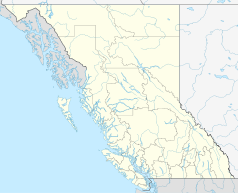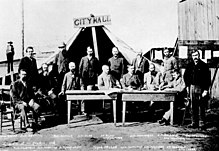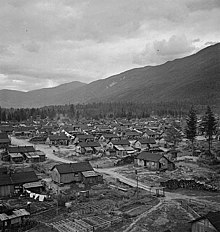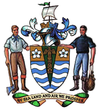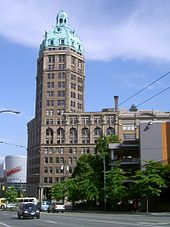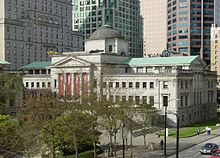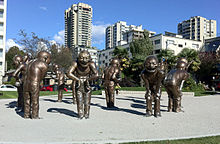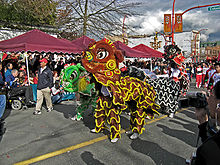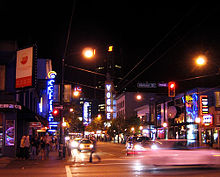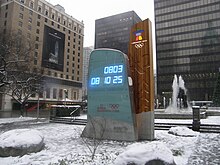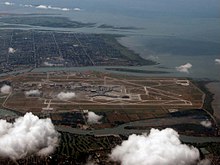Vancouver
| Vancouver | ||
|---|---|---|
 Vancouver skyline |
||
 coat of arms |
 flag |
|
|
Motto : By Sea, Land, and Air We Prosper ( We create wealth on water, on land and in the air) |
||
| Location in British Columbia | ||
|
|
||
| State : |
|
|
| Province : | British Columbia | |
| Regional District : | Metro Vancouver | |
| Coordinates : | 49 ° 17 ′ N , 123 ° 7 ′ W | |
| Height : | 10 m | |
| Area : | 114.67 km² | |
|
Inhabitants : - Metropolitan Area : |
631,486 (as of 2016) 2,463,431 (as of 2016) |
|
| Population density : | 5,507 inhabitants / km² | |
| Time zone : | Pacific (UTC-8 / -7) | |
| Postal code : | V5K - V6Z | |
| Foundation : | 1886 | |
| Mayor : | Kennedy Stewart | |
| Website : | www.vancouver.ca | |
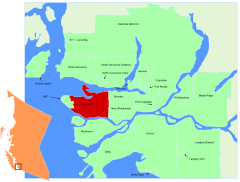 Location in the Metro Vancouver area |
||
Vancouver ( English pronunciation [ væŋˈkuːvɚ ] or [ vænˈkuːvɚ ]) is a city in southwest British Columbia on the west coast of Canada . It lies between the Strait of Georgia and the Coast Mountains , around 45 kilometers northwest of the US border . The city is part of the Metro Vancouver regional district , which with 2,463,431 inhabitants is the largest metropolitan area in Western Canada and the third largest in the country after Toronto and Montreal. The population of the actual city of Vancouver is 631,486. The city is named after the British captain George Vancouver , who explored and measured the region at the end of the 18th century. The name Vancouver itself comes from the Dutch "van Coevorden", derived from the city of Coevorden .
The city emerged in the 1860s as a result of the wave of immigration during the Fraser Canyon gold rush and, after the opening of the transcontinental railroad in 1887, developed from a small sawmill settlement into a metropolis within a few decades . The economy was initially based on the exploitation of British Columbia's natural resources: forestry , mining , fishing, and agriculture . The Port of Vancouver gained international importance after the opening of the Panama Canal . It is now the largest in Canada and exports more goods than any other port in North America .
Over time, Vancouver transformed itself into a service center and (especially after the world exhibition Expo 86 ) a destination for tourists. The city is also the third most important location for the North American film industry after Los Angeles and New York and is therefore also known as " Hollywood North ". Finance also plays an important role. In a ranking of the most important financial centers worldwide, Vancouver ranks 15th (as of 2018). In the city ranking of the consulting firm Mercer , Vancouver took fifth place out of 231 major cities worldwide in terms of quality of life in 2018 .
Vancouver hosted the XXI. Winter Olympics . Some of the games' competitions were held in Whistler , 125 kilometers from Vancouver . After Montreal in 1976 and Calgary in 1988, Vancouver became the third Canadian city to host the Olympic Games .
geography

Location and neighboring places
Vancouver is on the Georgia Strait , an estuary that is shielded from the Pacific Ocean by Vancouver Island . The 114.67 km² urban area extends on the Burrard Peninsula , between the approximately 25 km long Burrard Inlet in the north and the Fraser River in the south. English Bay is on the west side of the peninsula . On its north coast, the Burrard Peninsula is divided again by another arm of the sea, the approximately two-kilometer-long False Creek . On this smaller peninsula are the city center (Downtown) and Stanley Park , one of the largest urban parks in North America. On the west side of the park, Siwash Rock rises , a prominent rock of volcanic origin. The urban area of Vancouver comprises flat and hilly terrain, the highest point is 167 m above sea level. NN, on Little Mountain in Queen Elizabeth Park .
The city is known for its scenic location. Towering mountains shape the cityscape; these belong to the North Shore Mountains , the southernmost chain of the Coast Mountains . The three local mountains Grouse Mountain (1231 m), Mount Seymour (1449 m) and Mount Strachan (1454 m) lie on the north bank of the Burrard Inlet directly opposite the city. On a clear day, the Mount Baker volcano , located in the US state of Washington, can be seen in the southeast . The mountains on the Sunshine Coast in the northwest and Vancouver Island in the west and southwest round off the scenery.
The neighboring communities of Vancouver are West Vancouver in the northwest, North Vancouver in the north, the District North Vancouver in the northeast, Burnaby in the east and Richmond in the south. The University Endowment Lands in the West are an unincorporated community and form part of the Greater Vancouver Electoral Area A .
vegetation
The original vegetation of Vancouver and its suburbs was temperate rainforest , consisting of conifers as well as isolated maples and alders , interspersed with swamps (due to the poor drainage even at higher altitudes). The conifers were a mix of sitka spruce , giant leopard , western hemlock , Douglas fir, and Pacific yew, typical of the British Columbia coast . It is only on Elliott Bay in Seattle that the mightiest trees of these species are said to have been even larger than on Burrard Inlet and English Bay. The tallest trees in Vancouver's primary forest were in the Gastown area , where forestry first began, and on the south shores of False Creek and English Bay (particularly Jericho Beach ). Most of the trees in Stanley Park are secondary forest , but there are also some trees that are under special protection and marked that were worked by Indians in pre-European times ( culturally modified trees ).
Numerous species of plants and trees that grow in Vancouver and the rest of the Lower Mainland have been imported from other parts of North America and other continents. Different types of palm have adapted to the climate and are often found, but also a large number of other exotic trees such as monkey tail and Japanese maple as well as flowers such as magnolias , azaleas and rhododendrons . Numerous rhododendrons have grown to enormous sizes, as have other species from the colder climates of eastern Canada and Europe. Many streets in the city have been lined with Japanese cherry trees donated by Japan since the 1930s .
climate
Compared to the Canadian average, the climate in Vancouver is unusually mild due to the influence of the Kuroshio Current. Winters are the fourth warmest in the cities covered by the Canadian Department of the Environment, after Victoria , Nanaimo and Duncan (all located on nearby Vancouver Island ). The proximity to the sea creates a microclimate , winter temperatures are usually 2 to 4 ° C warmer and summer temperatures 3 to 8 ° C colder than inland. The lowest daily temperature falls below freezing point on an average of 46 days a year, and below −10 ° C on only two days. The average daily highs in July and August are around 22 ° C, but in some cases they can rise to more than 26 ° C.

Vancouver is considered a rainy city, with an average of 166 days of rain per year. Between November and March can be up to 20 days in succession often rain fall when as Pineapple Express (Pineapple Express) called subtropical wind flow warm and moist air from Hawaii approach leads. As a rule of thumb, around 100 mm more precipitation can be expected for every 100 meters of altitude. Snow falls far more frequently in the higher eastern and northern suburbs than in the city and at sea level. The annual amount of snow is barely half a meter, but even light snowfall can close schools and cause large-scale traffic problems. This has to do with the fact that the snow is very wet because of the coast and through the repeated rise and fall in temperature above or below freezing slippery roads forms.
There are up to six thunderstorms annually . These usually occur in late autumn and winter and are sometimes accompanied by hail . The low number is due to the fact that the Georgia Strait rarely warms up enough to create ideal conditions for thunderstorms.
| Vancouver, 1981-2010 | ||||||||||||||||||||||||||||||||||||||||||||||||
|---|---|---|---|---|---|---|---|---|---|---|---|---|---|---|---|---|---|---|---|---|---|---|---|---|---|---|---|---|---|---|---|---|---|---|---|---|---|---|---|---|---|---|---|---|---|---|---|---|
| Climate diagram | ||||||||||||||||||||||||||||||||||||||||||||||||
| ||||||||||||||||||||||||||||||||||||||||||||||||
|
Vancouver Average Monthly Temperatures and Rainfall, 1981-2010
Source:
|
||||||||||||||||||||||||||||||||||||||||||||||||||||||||||||||||||||||||||||||||||||||||||||||||||||||||||||||||||||||||||||||||||||||||||||||||||||||
City structure
Vancouver is divided into 23 boroughs, called neighborhoods :
|
|
history
Pre-European settlement

Archaeological evidence suggests that the First Nations presence in the Vancouver area dates back about 4,500 to 9,000 years. At the time of the first encounter with Europeans, there were numerous settlements of the Musqueam , Squamish , Stó: lō , Tsawwassen and Tsleil'wau-tuth , who belong to the coastal Salish , on the lower Fraser River and on the adjacent Pacific coast . These tribes between Vancouver Island and Washington State are closely linked by language and culture, but also by kinship and trade.
Although food procurement was based on gathering and hunting, they had a comparatively highly developed culture with great social differentiation. As in contemporary Europe, society was divided into three parts: a dominant "nobility", simple tribesmen and slaves. Their economic system rewarded hard work, the accumulation of wealth, and the social redistribution of that wealth, especially through the leading families, the heads of which the Europeans referred to as chiefs . The winter quarters in the Vancouver area consisted of large longhouses built from the wood of the giant arborvitae . The potlatch ceremonies were an important part of the social and spiritual life of these tribes.
European discovery and settlement
In 1791, the Spanish captain José María Narváez was the first European to sail along the coasts of what is now Vancouver. A year later, British Captain George Vancouver explored the Strait of Georgia , Burrard Inlet, and Puget Sound . The first European to reach the area by land was Simon Fraser , a fur trader from the North West Company , who explored the entire length of the Fraser River, named after him, with his companions in 1808.
As a result of the Fraser Canyon Gold Rush (1858-1860) and in particular the Cariboo Gold Rush (1861-1862), around 25,000 men, many of them from California , moved to the Fraser River catchment area. The first permanent European settlement, McCleery Farm, was built in 1862 on the riverbank, east of the Musqueam winter camp in what is now the Marpole district. In 1863 the first sawmill went into operation in Moodyville (now North Vancouver ) and established the traditional forestry . More sawmills soon sprung up on the south bank of Burrard Inlet, which was then owned by Captain Edward Stamp. Stamp, who had worked as a lumberjack around Port Alberni , first set up a sawmill at Brockton Point, at the eastern end of Stanley Park . But treacherous currents and reefs forced him to relocate in 1865. Stamp's Mill was built at a location near what is now Gore Street .
The various sawmills in the area were important manufacturers of wood products for shipping. Many of the masts of the numerous tall ships and the steadily growing ships of the Royal Navy were made of wood from the Vancouver area. Among the numerous orders was one from the Chinese emperor, who ordered dozens of giant beams for the Gate of Heavenly Peace in the Forbidden City in Beijing .
Immediately adjacent Stamp's Mill , the settlement was Gastown . It was named after John Deighton , whose nickname was "Gassy Jack" and who had opened a pub there in 1867. In 1870, the colonial government of British Columbia had surveyed the settlement and named it on March 1 in honor of Lord Granville , Minister for the Colonies, officially Granville . This designation never caught on and the district is still called Gastown today.
The settlement was located on a natural harbor and for this reason was determined in 1885 by the Canadian Pacific Railway (CPR) instead of Port Moody, 20 km to the east, as the western terminus of the transcontinental railway line. The construction of the line was one of the prerequisites for British Columbia's accession to the Canadian Confederation in 1871. CPR President William Cornelius Van Horne campaigned for the name of the place to be changed to Vancouver, as in his opinion the people in the east of the country knew where Vancouver Island was, while Gastown or even Granville were completely unknown.
After the city was founded
On April 6, 1886, the city was officially founded with the new name Vancouver. A slash-and- burn burn , which got out of control by a violent gust of wind, almost completely destroyed the young city on June 13 of the same year. Within 45 minutes, more than 1000 wooden houses were destroyed by the flames, but reconstruction began the following day. The first train arrived on May 23, 1887 at the Waterfront Station on the banks of Burrard Inlet. Thanks to the economic boom sparked by the railroad, Vancouver quickly recovered, growing from 5,000 residents in 1887 to 15,000 in 1892 and 100,000 in 1900.
In the first few decades, large corporations dominated economic activity, as they had the necessary capital to drive the city's quantitative and qualitative growth. Some industries developed, but the backbone of the urban economy was the exploitation of natural resources. First forestry dominated, later export traffic via the port of Vancouver . The port benefited in particular from the opening of the Panama Canal in 1914, as it created a more direct export route to Europe . During the First World War , around a third of the False Creek inlet was filled in to make room for more rail systems, particularly the Pacific Central Station of the Canadian Northern Railway (later the Canadian National Railway ).
The domination of the big corporations often led to violent labor movements . The first major strike took place in 1903 when CPR railroad workers demonstrated for the recognition of their union. In 1918 Vancouver was the starting point for the first Canadian general strike . Other social movements such as feminists , moral innovators, and teetotalers also influenced urban politics. In 1906 the city council tried unsuccessfully to close the brothels on Dupont Street. During the First World War and until 1921 an alcohol prohibition law was in force.
During the 1920s, Vancouver was repeatedly hit by racially motivated violence, particularly against the Chinese and Japanese ; various newspapers warned of an "oriental threat".
On January 1, 1929, the area of the city of Vancouver was expanded to the current extent with the incorporation of Point Gray and South Vancouver. Since then, it has covered almost the entire western part of the peninsula between Burrard Inlet and the Fraser River. The population on that day was 228,193, making Vancouver the third largest city in the country. The economic boom of the 1920s ended abruptly with the Great Depression . The neighboring communities of North Vancouver and Burnaby had to file for bankruptcy, while Vancouver barely managed to avert it. Thousands of young people traveled to Vancouver across Canada in the hope of finding work. The communists, who organized mass strikes several times, were very popular in the slums. Many of the Mackenzie Papineau battalion that fought in the Spanish Civil War were from Vancouver.
The outbreak of the Second World War gave the region a rapid economic boom. The shipyards produced corvettes and minesweepers for the Royal Canadian Navy and the Boeing plant in neighboring Richmond produced parts for B-29 bombers. In 1942, a few months after the attack on Pearl Harbor , the Canadian government viewed the Japanese-born Canadians as a national security threat, much like the Germans did during World War I. The Canadians of Japanese descent were also expropriated, rounded up in Hastings Park and then interned in inland camps. It was not until 1988 that the government officially apologized and paid compensation.
Since 1950
In December 1953, CBUT, the first television station in Western Canada , began broadcasting. Several new bridges created better traffic connections. The Second Narrows Bridge (1925) and the Lions Gate Bridge (1938) on the north bank of Burrard Inlet had been built before the war. 1957 followed the Oak Street Bridge over the Fraser River to Richmond and 1960 the Ironworkers Memorial Second Narrows Crossing over the Burrard Inlet.
Two new universities were founded in the suburb of Burnaby , both of which have branches in Vancouver today and which complement the University of British Columbia , which was founded in 1908 : The British Columbia Institute of Technology started in 1960 , followed by Simon Fraser University in 1965 . Residents of the Chinese-influenced Strathcona district formed a protest movement in the late 1960s and prevented the demolition of this area, which was to give way to a planned motorway. The protests led to a rethink in transport policy and, in 1980, to the ban on further highways in the city. In 1971, Greenpeace was founded in Vancouver , today one of the world's most important environmental protection organizations. The continued growth of Vancouver International Airport on Sea Island made it necessary to build another bridge over the Fraser River, the Arthur Laing Bridge was inaugurated in 1976.
After Vancouver was awarded the contract to host the 1986 World Exhibition , a building boom began in the city, which continues to this day with a few short interruptions. In 1983 the BC Place Stadium was opened, the first indoor stadium in Canada. In January 1986 the first line of the SkyTrain followed , an elevated railway that connects Vancouver with the suburbs. Other striking buildings that were created with a view to Expo 86 and have shaped the cityscape since then are Science World , Canada Place and the Plaza of Nations .
The world exhibition, which lasted from May to October 1986 and was the last in North America to date, proved to be a great success with over 20 million visitors. The exhibition area on the north bank of False Creek had previously been an extensive industrial wasteland and was sold to Hong Kong entrepreneur Li Ka-shing after the exhibition . He implemented one of the largest urban development projects in North America, and within a few years False Creek transformed into a high-density and attractively located residential area on the outskirts of the city center. As early as the 1970s, the Granville Island peninsula in False Creek had been converted from an industrial zone into a popular shopping and cultural district. This sustainable urban planning increased the quality of life in the region.
In 1998 the National Olympic Committee of Canada decided to apply to host the 2010 Winter Olympics . In the intra-Canadian elimination, Vancouver received the most votes, ahead of Québec and Calgary . On February 22nd, 2002, 63.9% of the participating voters approved the candidacy in a (legally non-binding) municipal referendum. Vancouver was awarded the contract on July 2, 2003 in the 115th IOC session in Prague and prevailed against Pyeongchang and Salzburg .
Since then, the city has been using the improved transport infrastructure for the Olympic Games for targeted urban development at junctions. The Canada Line stops , which connects Vancouver's waterfront with Richmond and the airport, will become centers of urban development and local amenities in the city and in Richmond . Although the organizing committee for the Games was able to present a balanced balance sheet, this did not include the costs for the construction of the new infrastructure for the Olympic Games, which have since placed a considerable strain on the budget of the city of Vancouver. The province's debt also increased by CAD 24 billion in ten years because of the Games .
The immigration policy of the United States, which since Donald Trump's election as president has prevented American companies from recruiting employees, has led them to switch to Canada and in particular to Vancouver. Microsoft founded its Microsoft Canada Excellence Center (MCEC) in Vancouver with 750 employees . By 2020, 50,000 new technology jobs are to be created there, and Vancouver is now the leading Canadian city for start-ups . However, this leads to rapidly growing property prices and rents. Amazon has been buying real estate since 2015 and having new ones built to accommodate at least 5,000 employees.
population
Multicultural society
|
Proportion of minorities in the population |
|
|---|---|
| ancestry | Share in percent |
| Chinese | 29.9 |
| South Asians | 5.7 |
| Filipinos | 4.1 |
| Southeast Asians | 2.5 |
| Japanese | 1.5 |
| Korean | 1.1 |
| African American | 0.9 |
| West Asians | 0.6 |
| Multiple answers | 0.8 |
People of many ethnicities and religions live in the city, which has resulted in a multicultural society . 47.1 percent of the population belong to a “visible minority group” (visible minority, i.e. all non-whites or non-Caucasians with the exception of First Nations , Inuit and Métis ) by the Canadian statistical agency . Vancouver has the highest rate of intercultural marriages in Canada at 7.2 percent (the national average is 3.2 percent).
Since the first years of European settlement in the second half of the 19th century, people from the British Isles formed the largest immigrant group and are still the largest ethnic group in Vancouver. Until the 1960s, the city was markedly British, as most British immigrants moved here directly without having previously lived in the eastern Canadian provinces. The British influence on cultural life is particularly noticeable in the districts of South Granville and Kerrisdale. Before the 1980s, people of German descent formed the second largest group, followed by those from the Ukraine and Scandinavia . Most European immigrants or their descendants have meanwhile been fully assimilated .
With a share of almost 30 percent, the Chinese are by far the largest non-European population group. They came to British Columbia in two major waves of immigration, in the second half of the 19th century during the Fraser Canyon gold rush and during the construction of the transcontinental railroad, and in the 1980s and 1990s before Hong Kong was handed over to the People's Republic of China . Of the Chinese languages spoken in Vancouver, Cantonese is the most widely spoken. Other significant ethnic groups from Asia are Indians (especially from the Punjab , commonly referred to as Indo-Canadians), Vietnamese , Filipinos , Koreans , Khmer and Japanese .
After Toronto and before Montreal , Vancouver is the second most popular destination for immigrants in Canada. There are several districts that are strongly influenced by a certain ethnic group. In addition to the second largest Chinatown in North America (after San Francisco ), Vancouver also has areas in which Indian (“Punjabi Market”), Italian (“Little Italy”), Japanese (“Japantown”), Korean (“Koreatown”) or Greek ("Greektown") influences can be felt.
First Nations and invisible minorities
The ten First Nations in Greater Vancouver have a special role in several ways. Thus, the traditional areas of the Indians delimit legal districts in which the state is obliged to consult in good time on all matters relating to this area. That has z. As a result, for example, government buildings may not be sold without consulting the First Nation concerned. In addition, the Musqueam, for example, whose traditional area is largely occupied by the university, have leased land there and maintain a special relationship with the university itself. In addition, the First Nations are not considered to be a "visible minority".
In 2001 there were 22,700 Indians living in the Vancouver District, of whom 17,475 were registered status indians and 5,225 were non-status indians ; 10,445 lived in Vancouver itself. In 2006, 23,515 Indians lived in the city. The total of 22 reserves in the greater Vancouver area cover only 17.22 km² or 0.6 percent of the total area. In addition, in 2001 there were 12,505 Métis in the city , their number rose to 15,075 by 2006, and 260 Inuit , the number of which fell to 210. In addition, there were 1395 people with mixed affiliations or from other indigenous populations. This means that 21.7 percent of British Columbia's natives lived in Greater Vancouver; in 2006 it was exactly 40,310.
Religions
There is no dominant religion or denomination in Vancouver. According to the 2001 census, the Roman Catholics make up the largest proportion of the population with 19.0 percent. This goes back on the one hand to immigration from Catholic countries like Italy, on the other hand to the fact that the first missionaries among the First Nations were Catholic members of the order, especially Oblates . Various Protestant denominations belong to 17.4 percent, whereby due to the British origin of many residents, the Anglican community that emerged in Great Britain dominates. 1.7 percent described themselves as Orthodox Christians , which is largely due to Ukrainian and Greek immigration, while 4.4 percent said they belonged to an unspecified Christian denomination. Mainly of Chinese origin are the followers of different directions of Buddhism with a share of 6.9 percent. Supporters of Sikhism and Hinduism come mainly from the Indian subcontinent with 2.8 percent and 1.4 percent respectively. 1.8 percent of the population profess Judaism, 1.7 percent Islam and 0.8 percent other religions.
42.2 percent gave no religious affiliation. Like the rest of the province of British Columbia, the city has a low percentage of regular worshipers compared to the rest of the North American continent. While this was 67 percent in 1946, it decreased continuously in the course of the following decades and was only 20 percent in 2001.
The Roman Catholic Archdiocese of Vancouver replaced the older New Westminster diocese in 1908. It covers the southwestern part of the province of British Columbia excluding Vancouver Island. The bishopric is the Holy Rosary Cathedral , built in 1899/1900 . Catholic Roman with the Church in union , the Ukrainian Greek Catholic Church , with Vancouver for the eparchy , which forms part of New Westminster part of archeparchy Winnipeg. The Anglican diocese of New Westminster moved its seat to Vancouver in 1929 to Christ Church Cathedral , built in 1894/95 . The diocese forms part of the ecclesiastical province of British Columbia and the Yukon . The Holy Trinity Cathedral belongs to the Ukrainian Orthodox Church of Canada ; it is one of two cathedrals of the Diocese of Edmonton and Western Canada, which is connected to the Ecumenical Patriarchate of Constantinople .
The most widespread branch of Buddhism that came to the region with the Asian immigrants is Amitabha Buddhism , which is predominant in East Asia . The most important temple in the metropolitan area is the International Buddhist Temple in neighboring Richmond .
The Jewish community of Vancouver, which can also be traced back to the phase before the city was actually founded, is now the third largest in Canada. Conservative Judaism has the most members , followed by Reform Judaism and Orthodox Judaism .
At the beginning of the 20th century, Sikhs, Hindus and Muslims who came from what was then British India also moved here . The former British colonial empire has shaped its former colony Canada to this day.
Visible social problems
The economic boom and the need for housing among wealthy immigrants has led to steep increases in rents. As a result, around 100,000 people in the metropolitan region of Vancouver are at risk of homelessness, around 2,200 live on the streets in Vancouver. In addition, there is an increasing number of drug addicts, prostitution and crime.
The street level social problems , i.e. the problems that are recognizable on the street, are increasing. For some years now, they have not only affected the well-known districts such as Downtown Vancouver, but also Metrotown in Burnaby and the Whalley / Center City area in Surrey. Yet in 2005, 63 percent of the homeless were concentrated in Vancouver itself, while 21 percent are in the sub-region south of the Fraser River. Homelessness, but above all drug addiction, prostitution and (procurement) crime are closely linked. The desolate living situation of several hundred residents is easy to spot , especially around East Hastings Street (also known as Downtown Eastside , or DTES for short) between downtown and Chinatown.
Population development
The following overview shows the development of the population according to the results of the census. The figures before 1931 do not take into account the results of the incorporated suburbs of Point Gray and South Vancouver.
|
|
life quality
Numerous statistics and surveys according to Canada in general and Vancouver in particular achieve top rankings for quality of life. Vancouver is regularly rated as one of three cities with the world's highest quality of life. This has made the metropolis the most livable city in Canada for many years. Many see the unusually mild climate as one of the main reasons why Vancouver is ahead of other Canadian cities (such as Toronto , Calgary and Montreal ) that are also well ahead . In a ranking of the cities with the highest quality of life worldwide, the company Mercer , Vancouver took fifth place in 2018.
In addition to surveys, such surveys also use statistics on, for example, unemployment rates, crime and the like.
Politics and law

The Vancouver Charter, enacted in 1953, gives the city more powers than other parishes subject to the BC Municipalites Act , the municipal law of the province of British Columbia. The city is governed by a city council (Vancouver City Council) , which is composed of ten MPs plus the mayor . There is also a school council with nine and a park council with seven members. The councils are elected every three years on a proportional basis, with the entire city forming a single constituency. The introduction of the majority vote with single-constituencies, which is otherwise common in Canada , was rejected in a referendum on October 17, 2004.
In Canada, the parties are strictly separated from each other at the federal and provincial levels (members of one party level do not necessarily have to belong to the other). In Vancouver this system continues at the local level. Since the 1940s, the dominant center-right standing Non-Partisan Association (NPA) urban policy and is since then with few interruptions the mayor. Opposite her is the center-left association thereof Coalition of Progressive Electors (COPE). Vision Vancouver, which is in the middle of the political spectrum , split off from COPE in 2005. In the last election on November 15, 2008, Vision Vancouver won eight seats, including the newly elected Mayor Gregor Robertson (his predecessor Sam Sullivan of the NPA had failed in the party elimination). COPE won two seats, the previously ruling NPA one seat.
Traditionally, the more affluent residents of the western districts tend to be conservative and liberal , those in the eastern districts tend to be more left-wing . A consensus has been established across the entire political spectrum on some issues : urban parks are protected from development, the expansion of public transport has priority over the construction of urban highways, and drug users are not prosecuted.
In April 2019, the city declared a "climate emergency" due to global climate change and announced an action program to reduce CO 2 in its area of influence.
Representation at provincial and federal level
In the Legislative Assembly of British Columbia , Vancouver is represented by ten deputies who are elected in as many constituencies. In the last election on May 17, 2005, the British Columbia Liberal Party and the British Columbia New Democratic Party each won five seats.
In the Canadian House of Vancouver is represented by five deputies. In the October 14, 2008 election , the Liberal Party won three seats and the New Democratic Party two seats. The ruling Conservative Party has no representative from Vancouver.
police
While Division E of the Royal Canadian Mounted Police (RCMP) is responsible for security in most of the Lower Mainland region , Vancouver has its own police department, the Vancouver Police Department . According to the 2016 annual report, the Vancouver Police Department has 1,716 personnel (1,327 police officers and 389 civilian employees) and has a budget of approximately C $ 265 million to carry out its duties . In 2006 the city police set up their own counter-terrorism unit, which led to speculation about possible tensions with the RCMP, which is actually solely responsible for national security matters. The Greater Vancouver Transportation Authority Police Service , formed in December 2005, ensures safety on public transport. In 2005, Greater Vancouver had the fourth highest crime rate among metropolitan cities in Canada. The number of property crimes is particularly high and one of the highest in North America, but has decreased by 10.5 percent between 2004 and 2005. The majority of property crimes are car thefts.
Town twinning
In 1944, through its partnership with Odessa, Vancouver was one of the first cities to enter into an international city partnership . Since then, further city partnerships have been added.
|
badges and flags
| Foundation of the coat of arms: The coat of arms of Vancouver has existed in its current form since 1969 and was awarded by the College of Arms . The escutcheon shows - framed by shield holders , helmet , helmet gems and motto - four blue and white wavy bars, above each a dogwood blossom with white petals, green petals and orange carpel in the corners . The shield is divided by an Indian totem pole that tapers downwards . |
The flag of Vancouver , hoisted for the first time in 1983, consists of a green triangle in the leech with the city plaque on a gold shield and alternating blue and white waves on the flight side .
Culture and sights
Architecture and cityscape
From a structural point of view, Vancouver is a very young city, which is why modern buildings characterize the cityscape. Some are architecturally outstanding, such as the main building of the Vancouver Public Library, reminiscent of the Coliseum , or the tent-like building Canada Place , the former Canadian pavilion of the 1986 World's Fair.
Some striking buildings from the first decades of the 20th century have been preserved. These include the neoclassical Vancouver Art Gallery (a former courthouse) and the terracotta-brick Dominion Building . The latter was the tallest building in the British Empire from 1908 to 1910 ; this role was then played by the Beaux-Arts-style Sun Tower with its striking green dome until 1912 . One of the city's landmarks is the Marine Building , built in 1930 in Art Deco style , which is modeled on the New York Empire State Building . For more than three decades, from 1939 to 1972, the Hotel Vancouver was the tallest building in the city. The Qube was the 1970th
The list of tallest buildings in Vancouver is the Living Shangri-La, completed in January 2009, with a height of 201 m (as of 2010). In 1989 the city council approved " view protection guidelines " which were expanded in 1990. These define several corridors in the city center, in which the buildings must not exceed a certain height, in order to guarantee an unobstructed view of the North Shore Mountains . The guidelines proved to be a successful urban development measure, but the Vancouver skyline was found by many to be flat and visually uninteresting.
In 1997 the city council commissioned a study to see if taller buildings could be built to accentuate the skyline without disrupting mountain views. As a result, five locations were identified where the buildings may exceed the limit of 137 m, and two further locations in the northwest of the central business district, where the buildings may be up to 122 m high (31 m higher than the limit applicable there) . Eight years later, five of these seven sites were built on or in the approval phase. The tallest of these new buildings was the Living Shangri-La, which surpassed the tallest building to date, the One Wall Center , by 51 meters.
The numerous parks and gardens in Vancouver are a total of 1,298 hectares, which is around eleven percent of the area of the city. The largest is the 404-acre Stanley Park with the Vancouver Aquarium . Queen Elizabeth Park is also important. In Chinatown is the Dr. Sun Yat-Sen Classical Chinese Garden . Vancouver has two botanical gardens, the VanDusen Botanical Garden in the Shaughnessy district and the UBC Botanical Garden (including the Nitobe Memorial Garden ) on the grounds of the University of British Columbia .
Arts and Culture
Museums and galleries
Vancouver has several museums and galleries. Located in a former courthouse, the Vancouver Art Gallery is the largest art museum in Western Canada with around 8,000 works of art (including 200 significant works by Emily Carr and illustrations by Marc Chagall ). In the Vancouver Maritime Museum , a shipping museum, the schooner St. Roch is on display, the first ship ever to complete the Northwest Passage from the Pacific to the Atlantic. The Museum of Anthropology on the University of British Columbia is one of the premier museums of First Nations culture in the Pacific Northwest , while the Museum of Vancouver is the largest urban museum in the country. Science World deals with the world of science in a playful way, the Vancouver Police Centennial Museum brings visitors closer to the history of the Vancouver police force.
Sculptures and a steam clock
The Chinese artist Yue Minjun created a sculpture park with 14 bronze sculptures under the title A-maze-ing Laughter and set up as part of the “Vancouver International Biennale” (2009–2011). The Laughing Men Sculpture - each about eight feet high - is located near Morton Park.
In 1986, the Greater Vancouver Cultural Community formed an alliance to promote and develop cultural diversity in the region. Today the alliance serves as a mouthpiece for around 320 groups and artists. Its aim is to create a higher level of acceptance for art in the city and to clarify the contribution of art to social life.
A special feature in Gastown is the steam clock , a steam- powered public clock that whistles every 15 minutes.
Theater and music
Notable theaters in Vancouver include the Arts Club Theater Company, Vancouver Playhouse Theater Company, Touchstone Theater, Studio 58, Carousel Theater, and United Players of Vancouver. Outdoor shows are offered by Bard on the Beach and Theater Under the Stars during the summer . In addition, the Fringe Festival and the International Film Festival take place every year .
Vancouver plays an important role in the development of Canadian music, especially in the areas of classical, folk and pop. The city was a leader in the development of punk with bands such as DOA and No Means No , but also in post-industrial , whereby Skinny Puppy , Delerium and Front Line Assembly should be mentioned above all . Bryan Adams , Nickelback , Diana Krall , Sarah McLachlan , Michael Bublé and Loverboy are more adapted to mainstream tastes . The best-known hip-hop formation is Swollen Members .
Larger rock and pop concerts take place in the Rogers Arena , BC Place Stadium and the Pacific Coliseum , while lesser-known artists perform in the Plaza of Nations , the Commodore Ballroom, the Orpheum Theater or the Vogue Theater. Vancouver hosts two major music festivals each year, the Vancouver Folk Music Festival and the Vancouver International Jazz Festival . Vancouver also has two professional orchestras, the CBC Radio Orchestra and the Vancouver Symphony Orchestra . The Vancouver Opera performs at the Queen Elizabeth Theater.
Regular events and leisure opportunities
One of the most famous events is the Celebration of Light , a fireworks competition with music on the beaches of English Bay , which is followed by over 1.5 million viewers at the end of July and beginning of August. The city's ethnic minorities also contribute to the cultural scene, especially the Chinese. They celebrate the Chinese New Year with a large parade and hold an international dragon boat race on False Creek in June .
Vancouver has an influential lesbian and gay movement . In July 2003, British Columbia became the second Canadian province to recognize same-sex marriage as a constitutional right, a few weeks after Ontario . The gay and lesbian scene is concentrated around Davie Street in the city center; this area is also known as Davie Village . Every year one of the largest gay pride parades in the country takes place in Vancouver .
In the past, the nightlife in Vancouver was rather limited, unlike in other cities. Reasons for this were the early night's sleep for bars and nightclubs, as well as the reluctance of city authorities to encourage further development. This changed in 2003 when opening hours were extended and regulations relaxed. The city made efforts to establish the Downtown area (especially the Granville Street area) as an entertainment hub.
Sport and recreation
The most popular sport of the residents is ice hockey ; there are two professional teams , the Vancouver Canucks in the NHL and the Vancouver Giants in the WHL Junior League . The dominant team at the beginning of the 20th century were the Vancouver Millionaires , who won the Stanley Cup in 1915 . From 1973 to 1975 there was another professional team, the Vancouver Blazers , which belonged to the World Hockey Association .
Canadian football , the Canadian variant of American football , is practiced by the professional British Columbia Lions in the CFL . The Vancouver Canadians play in the Northwest League , one of the leagues in minor league baseball (lower-class professional baseball ). The Vancouver Whitecaps have one professional football team each for men and women who are represented in the Major League Soccer and the W-League . Professional basketball could not prevail, the NBA team Vancouver Grizzlies moved to Memphis (Tennessee) in 2001 .
Overview of professional sports teams:
The most popular team sports at the amateur level are Gaelic football and indoor lacrosse . Vancouver has hosted the Slam City Jam , the North American skateboarding championship , since 1994 . The Vancouver Marathon takes place in May and the 10-kilometer Vancouver Sun Run in April . From 1990 to 2004 Champ-Car races were held on a street circuit .
Sports for everyone are widespread in the Vancouver area, with many joggers in the parks and the waterfront, canoeists in False Creek and sailors in English Bay . There is also a well-developed network of cycle paths, beach volleyball courts, kayak rental stations, swimming pools and artificial ice rinks.
There are numerous beaches along the coast. These extend on the one hand on the western edge of the city center from Stanley Park to False Creek, on the other hand along the entire south coast of English Bay. The 18 km long beaches include First Beach, Jericho Beach, Kitsilano Beach, Locarno Beach, Second Beach, Spanish Bank, Sunset Beach and Third Beach.
In the nearby North Shore Mountains are the three winter sports areas Cypress Mountain , Grouse Mountain and Mount Seymour. These can be reached within half an hour from the city center, the winter season usually lasts from the beginning of December to the end of April. Whistler is around two hours away by car and offers other winter sports. An extensive network of hiking trails and mountain bike routes runs through the mountains , the latter being known as North Shore Trails . Canoeing and rafting are practiced on the Capilano River, Lynn Creek, and Seymour River . The North Shore Mountains also offer numerous opportunities for sport climbing .
The 1954 Commonwealth Games took place in Vancouver . The city hosted the World Police and Fire Games in 2009 and the 2010 Winter Olympics .
Economy and Infrastructure
economy
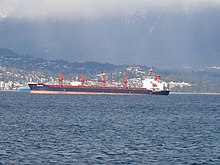
Commerce makes up the bulk of Vancouver's economy. The port of Vancouver is the largest in Canada and the second largest on the west coast of North America (it is the continent's largest in terms of exports). CAD 43 billion worth of goods are traded in more than 90 countries each year . The port creates around 69,200 jobs and generates four billion CAD gross domestic product .
Forestry is another mainstay of the Vancouver economy . Global corporations such as Canfor or West Fraser Timber (the world's second largest and third largest wood producer) have their headquarters here. Vancouver is also the headquarters of numerous mining companies such as Teck Resources and Goldcorp . The Stock Exchange of Vancouver, the Vancouver Stock Exchange (now part of the Toronto Stock Exchange ) is for small to medium mining companies of the world's most important market for venture capital . Vancouver has numerous branches of national and international banks and service companies (e.g. HSBC , RBC , BMO , CIBC ).
Vancouver is the third most important location for the North American film and television industry after Los Angeles and New York City . Around ten percent of all Hollywood films are shot in and around Vancouver, which is why the city is often referred to as " Hollywood North ". The Vancouver Film Studios are among the most important film and television studios in the world, and other companies in the film and television industry are based in various suburbs. Reasons for moving to Vancouver are the favorable exchange rate of the Canadian dollar, the same time zone as Los Angeles and the scenic and architectural diversity in Greater Vancouver, which makes it possible to recreate scenes from (almost) all over the world. The film industry is also benefiting from tax breaks from the Canadian government.
Numerous universities and the high quality of life led to the settlement of several cutting-edge technology and software companies. A particularly large cluster of computer game developers has formed in the region, the largest being Electronic Arts and Relic Entertainment . In addition, Vancouver is developing into a center of research on fuel cells . The world's leading manufacturer Ballard Power Systems, for example, has its headquarters in the neighboring city of Burnaby , while the Institute for Fuel Cell Research of the National Research Council of Canada is located in Vancouver.
The importance of tourism has increased significantly since the World Exhibition Expo 86 in particular . In addition to numerous sights, parks and beaches in Vancouver itself, it is above all the diverse nature in the area and the associated leisure activities that attract many tourists. The Whistler-Blackcomb Resort, 126 km to the north, is one of the most popular ski resorts in North America. There are also many summer and winter sports options in the nearby North Shore Mountains . Cruise ships operate regularly from Vancouver , usually towards Alaska . With almost 3.9 million foreign visitors, Vancouver was the 34th most visited city in the world in 2016. Tourists brought in $ 2.1 billion in revenue that same year. Most of the foreign visitors came from the USA and Asia.
traffic
Inner-city railways
Since 1998 the transport company TransLink has been responsible for almost all matters relating to transport in Metro Vancouver and parts of the adjacent Fraser Valley Regional District , with the exception of national rail and ferry transport and taxis. TransLink operates local public transport in this area and takes over part or all of the financing and maintenance of roads and bridges (excluding motorways).
The backbone of local public transport in Vancouver and the surrounding area is the fully automatic SkyTrain , which is largely designed as an elevated train . The Expo Line and Millennium Line run to Burnaby , New Westminster and Surrey . Since August 17, 2009 the Canada Line has been connecting the city center with Richmond and the airport. The Coast Mountain Bus Company and West Vancouver Blue Bus operate a dense bus network on behalf of TransLink . 13 lines are also served by the Vancouver trolleybus . This replaced the trams and interurbans of the British Columbia Electric Railway in 1948 , which existed from 1890 to 1958. In 2008 the city administration carried out studies on the reintroduction of the tram; the first line is to run from Granville Island along False Creek via the Waterfront station to Stanley Park. In 2019 this study was updated under the aspect of a potentially long-term realization. The Vancouver Downtown Historic Railway , a museum tram , runs along the south bank of False Creek on summer weekends . Historical omnibuses are also used as a tourist attraction in downtown Gastown .
Airport
The Vancouver International Airport is located in the neighboring city of Richmond on Sea Iceland , an island in the delta of the Fraser River. Vancouver's airport is the second largest in Canada and the second largest on the west coast of North America with international flights. Other major airports in the area are Abbotsford International Airport in Abbotsford and Boundary Bay Airport in Delta . In the city center there are also moorings for seaplanes and landing pads for helicopters.
Road network
Due to spatial planning measures and the geographical location, there are no highways in Vancouver with one exception . The only one is the Trans-Canada Highway in the far east of the city. All others narrow to main streets in front of the city limits. In general, the street network of the metropolis is structured according to a grid pattern. A 170 km long network of cycle paths runs through the city . Most of the cycle paths lead along traffic-calmed side streets, while cycle lanes predominate in the more densely populated city center.
Watercraft
There is no direct ferry service between Vancouver and Vancouver Island . Ferries from BC Ferries run from the Horseshoe Bay west of West Vancouver to Nanaimo and Bowen Iceland and from Tsawwassen in the town of Delta to Swartz Bay , near the provincial capital of Victoria and the Gulf Islands . The SeaBus ferry connects downtown Vancouver and North Vancouver .
The port makes the city the most important end point of the two transcontinental Canadian freight railways, the Canadian Pacific Railway and the Canadian National Railway . The American BNSF Railway (formerly Great Northern Railway ) also has a route to Vancouver. The Canadian Pacific reached the city in 1887, the Great Northern in 1891 and the Canadian Northern (predecessor of the Canadian National) in 1915. The railway companies offer direct freight trains to Chicago , the rail hub of North America, and to New York / New Jersey. The companies' necessary marshalling facilities are all outside the urban area. The route network of the British Columbia Railway, which has been part of the CN since 2004, ends in North Vancouver .
Long-distance rail transport
InterCity trains to other Canadian cities are offered by VIA Rail under the name The Canadian and depart from Pacific Central station. Amtrak Cascades offers a connection to Seattle . Great Canadian Railtour excursion trains operate under the name Rocky Mountaineer to Calgary , Jasper and Whistler . The West Coast Express is a commuter train that runs from Waterfront Station to Mission .
Intercity bus from Greyhound Canada reversed from the end of 2018 until the station Pacific Central, the business was however adjusted.
education
schools
The city of Vancouver forms the school district 39, with around 57,000 students and 119 schools the second largest in British Columbia. As in other parts of the province, there are a number of private schools that are eligible for partial state funding - including religious, secular and special needs schools, most of which charge additional tuition fees. There are also three schools that offer classes in French . These are subordinate to the Conseil scolaire francophone de la Colombie-Britannique , which is responsible for francophone students throughout the province.
Colleges and universities

There are two major state universities in the Vancouver area . The University of British Columbia (UBC) was founded in 1908 and is located immediately west of the city on the western tip of the Burrard Peninsula. Simon Fraser University (SFU), founded in 1965 , is headquartered in Burnaby . UBC and SFU have teaching facilities in Vancouver that are outsourced from their respective campuses . The British Columbia Institute of Technology at Burnaby is a technical university with offices in Vancouver, Richmond, and North Vancouver . In September 2007 a campus of the private Fairleigh Dickinson University was opened in Vancouver .
Major art schools include the Emily Carr University of Art and Design , the Vancouver Film School, and Studio 58 . Two technical colleges ( called college in Canada ) also offer higher education courses in Vancouver, these are the Vancouver Community College and the Langara College .
The Collège Éducacentre offers adult education in French.
media

Two regional daily newspapers appear in Vancouver, The Vancouver Sun and The Province . Both are published by Pacific Newspaper Group , a subsidiary of CanWest Global Communications . Two national daily newspapers, The Globe and Mail and National Post are also distributed. The three daily newspapers Ming Pao , Sing Tao Daily and World Journal are aimed at the Chinese-speaking part of the population. 24 Hours and Metro are free commuter newspapers . The Georgia Straight weekly is also free . The local newspaper Vancouver Courier appears twice a week .
In British Columbia, too, the nationally active television companies are represented by regional branches. The public broadcasters Canadian Broadcasting Corporation and Télévision de Radio-Canada , these are the stations CBUT and CBUFT , while commercial vendors Citytv , CH , Global and CTV with Citytv Vancouver , CHEK-TV , Global BC and CTV British Columbia are represented . The broadcaster Global BC has the highest market shares in the news sector. Channel m is aimed at the large number of immigrants and broadcasts in five Asian languages.
The three main radio stations are CBC Radio One , CKNW and News1130. There are also a number of sports or news channels, mainly on AM , as well as numerous music channels , the majority of which can be received on FM .
Personalities
Vancouver is the birthplace and place of work of numerous prominent personalities. Due to the great importance of the city for the North American film industry, many actors are represented among them. The best known include James Doohan (Star Trek) , Hayden Christensen (Star Wars) and Yvonne De Carlo (The Munsters) . Many well-known athletes come from Vancouver who have excelled in ice hockey, the Canadian national sport. Glenn Anderson is a six-time winner of the Stanley Cup, Olympic champion Paul Kariya is one of the most famous Canadians of Japanese origin.
Due to the very short terms of office, only a few mayors had a lasting influence on the development of the city. The first, Malcolm Alexander MacLean , led the rebuilding after the fire of 1886. Louis Denison Taylor held the office four times between 1910 and 1934, and his eleven-year term is the longest of any previous mayor. Larry Campbell's previous coroner function served as the template for the hit television series Da Vinci's Inquest . Gordon Campbell was Prime Minister of British Columbia from 2001 to 2011 and has been Canada's Ambassador to Great Britain since 2011.
Squamish chief Joseph Capilano (actually Su-á-pu-luck) also exerted influence on Canadian politics , who in 1906 brought a petition to the British king in order to protest against the expropriation and forced assimilation of the natives. The head of the Assembly of First Nations , Shawn Atleo , also from Vancouver. The environmental activist David McTaggart founded Greenpeace here .
literature
- Chuck Davies: The Greater Vancouver Book - An Urban Encyclopedia. Linkman Press, Surrey, British Columbia 1992, ISBN 1-896846-00-9
- W. Michael et al .: Horizons - Canada Moves West. Prentice-Hall, Upper Saddle River, New Jersey 2000, ISBN 0-13-012367-6
- Daniel Francis: LD - Mayor Louis Taylor and the Rise of Vancouver. Arsenal Pulp Press, Vancouver 2004, ISBN 1-55152-156-3
- Harold Kalman: Exploring Vancouver - Ten Tours of the City and its Buildings. University of British Columbia Press, Vancouver 1974, ISBN 0-7748-0028-3
Web links
- Vancouver ( English, French ) In: The Canadian Encyclopedia .
- Official website of the City of Vancouver
- Vancouver Tourism Authority
- Discover Vancouver
- History of Vancouver
- Art and culture in Vancouver
Individual evidence
- ^ Mayor Kennedy Stewart
- ^ Vancouver Census Metropolitan Area Profile. Census 2016. In: Statistics Canada . January 23, 2017, accessed February 27, 2017 .
- ^ Vancouver Community Profile. Census 2016. In: Statistics Canada. January 23, 2017, accessed February 27, 2017 .
- ↑ The Global Financial Centers Index 23. (No longer available online.) Archived from the original on March 27, 2018 ; accessed on July 13, 2018 . Info: The archive link was inserted automatically and has not yet been checked. Please check the original and archive link according to the instructions and then remove this notice.
- ↑ Mercer's 2018 Quality of Living Rankings. Retrieved May 23, 2019 .
- ↑ Fig. At Flickr: Culturally Modified Tree .
- ↑ A Short History of Our Trees ( Memento of the original from March 2, 2013 in the Internet Archive ) Info: The archive link was automatically inserted and not yet checked. Please check the original and archive link according to the instructions and then remove this notice. - Vancouver Cherry Blossom Festival
- ^ Weather and Climate in British Columbia
- ↑ Canadian Climate Normals 1981-2010: Vancouver International Airport
- ^ Davis: Greater Vancouver Book , p. 31
- ^ Carlson Davis: Greater Vancouver Book , pp. 34-36.
- ↑ Marpole ( Memento of the original from January 27, 2007 in the web archive archive.today ) Info: The archive link was automatically inserted and not yet checked. Please check the original and archive link according to the instructions and then remove this notice. - Discover Vancouver.
- ↑ History of Gastown ( Memento of the original from November 25, 2009 in the Internet Archive ) Info: The archive link was inserted automatically and has not yet been checked. Please check the original and archive link according to the instructions and then remove this notice. .
- ↑ The Great Fire ( Memento of the original from October 15, 2007 in the Internet Archive ) Info: The archive link was inserted automatically and has not yet been checked. Please check the original and archive link according to the instructions and then remove this notice. - Discover Vancouver
- ^ Davis: Greater Vancouver Book , p. 780
- ^ Paul A. Phillips: No Power Greater - A Century of Labor in British Columbia. BC Federation of Labor / Boag Foundation, Vancouver 1967.
- ↑ Patricia Roy: The Oriental Menace in British Columbia. In: Historical Essays on British Columbia. Gage, Toronto 1980, pp. 243-255.
- ↑ The best- known example is Baron Gustav Konstantin von Alvensleben , who had set up a project for tourists on the Indian Arm that had been started in 1906. Von Alvensleben was expropriated during the First World War. The then Custodian of Enemy Property , EJ Young, took over the entire company without compensation.
- ↑ Japanese Canadian Internment ( Memento of the original from June 13, 2007 in the Internet Archive ) Info: The archive link was inserted automatically and has not yet been checked. Please check the original and archive link according to the instructions and then remove this notice. - University of Washington Libraries
- ↑ Official result of the Olympic referendum ( memento of the original from December 1, 2005 in the Internet Archive ) Info: The archive link was inserted automatically and has not yet been checked. Please check the original and archive link according to the instructions and then remove this notice. .
- ↑ Choice of the venue 2010 - International Olympic Committee.
- ^ Atlantic Cities: Vancouver's Canada Line Is a Model of Transit-Oriented Development . 19th February 2014
- ↑ Vancouver 2010 Winter Olympics debt-free, VANOC final report says , CBC article dated July 3, 2014
- ↑ Vancouver's recession-rocked Olympics left a mixed economic legacy , article from Metronews.ca, January 10, 2014
- ↑ Luise Wagner: This city benefits most from Trump's H-1B phobia , Welt, October 14, 2017.
- ↑ Amazon opening another office within The Exchange in downtown Vancouver , Urbanized, October 31, 2018.
- ↑ a b c 2001 Vancouver Community Profile - 2001 Census Results from Statistics Canada.
- ↑ Canada's ethnocultural portrait - Statistics Canada, 2001
- ^ Statistics Canada
- ^ Statistics Canada
- ↑ A Profile of Aboriginal People, First Nations and Indian Reserves in Greater Vancouver ( Memento of the original from June 11, 2012 in the Internet Archive ) Info: The archive link was automatically inserted and not yet checked. Please check the original and archive link according to the instructions and then remove this notice. (PDF; 278 kB) - Policy & Planning Department, Metro Vancouver.
- ↑ Patterns of religious attendance (PDF; 73 kB) - telusplanet.net
- ↑ A journalist's guide to buddhism ( Memento of the original from June 14, 2010 in the Internet Archive ) Info: The archive link was inserted automatically and has not yet been checked. Please check the original and archive link according to the instructions and then remove this notice. - Center for Faith & the Media, pp. 14-16
- ↑ Pioneer Asian Indian Immigration to the Pacific Coast ( Memento of the original from November 30, 2007 in the Internet Archive ) Info: The archive link was automatically inserted and has not yet been checked. Please check the original and archive link according to the instructions and then remove this notice.
- ↑ Jens Tönnesmann: Creeping poverty. Deutschlandradio , May 20, 2006.
- ↑ Summary with the title Hard Times: A Portrait of Street Level Social Problems in Western Canada ( Memento of the original from November 14, 2012 in the Internet Archive ) Info: The archive link was inserted automatically and has not yet been checked. Please check the original and archive link according to the instructions and then remove this notice.
- ↑ The focus of the break-ins in the city area, for example, can be seen quite clearly. A map from 2006 shows the distribution in the city of Vancouver ( PDF ( Memento of the original from May 6, 2006 in the Internet Archive ) Info: The archive link has been inserted automatically and has not yet been checked. Please check the original and archive link according to the instructions and then remove this notice . ; 476 kB).
- ↑ City of Vancouver population ( Memento of the original from June 14, 2007 in the Internet Archive ) Info: The archive link was inserted automatically and has not yet been checked. Please check the original and archive link according to the instructions and then remove this notice. - Vancouver Public Library.
- ^ Dene Moore: Vancouver is North America's most liveable city: survey. Yahoo! News Canada, March 4, 2015, accessed April 12, 2015 . (English)
- ↑ Mercer's 2018 Quality of Living Rankings. Retrieved July 30, 2018 .
- ↑ Vancouver and Melbourne top city league - BBC News, October 4, 2002.
- ↑ Aussie rules: Melbourne ends Vancouver's decade-long reign as best city to live in - Daily Mail, September 2, 2011
- ^ Vancouver world's second-best place to live - CBC News, March 3, 2003.
- ↑ Vancouver remains the most liveable city - The Economist, April 28, 2008.
- ^ Vancouver Charter .
- ↑ Andrea Barbara Smith: The Origins of the NPA - A Study in Vancouver Politics . University of British Columbia, 1981.
- ^ Decision , engl.
- ^ Police Services Division, Ministry of Public Safety and Solicitor General, Province of British Columbia (2006), pp. 101, 106–110, 151, 154
- ^ Vancouver Police Department - 2016 Annual Report. (PDF, 6.85 MB) VPD, accessed on June 2, 2017 (English).
- ↑ VPD's war on terror requires a lot of legwork. Mike Howell in the Vancouver Courier , June 16, 2006.
- ^ Report for the attention of the city council on the subject of town twinning (PDF; 327 kB), City of Vancouver, March 4, 2008
- ^ Vancouver High-rise buildings - Emporis Buildings
- ↑ Downtown Vancouver Skyline Study - City of Vancouver, April 7 and 23, 1997.
- ^ About the Park Board - Board of Parks and Recreation
- ↑ About the Alliance for Arts and Culture ( Memento of the original from October 24, 2012 in the Internet Archive ) Info: The archive link has been inserted automatically and has not yet been checked. Please check the original and archive link according to the instructions and then remove this notice. - Alliance for Arts and Culture
- ↑ a b c German television newspaper Funkuhr , No. 13 (2009): Katharina Witt on the Canadian metropolis, which is a dream not only because of the Olympic Winter Games.
- ↑ Marriage for Same-Sex Couples in Ontario and British Columbia ( Memento of the original from January 10, 2007 in the Internet Archive ) Info: The archive link was inserted automatically and has not yet been checked. Please check the original and archive link according to the instructions and then remove this notice. - Human Rights Campaign
- ^ Police take aim at Vancouver's entertainment district - CBC, November 7, 2006
- ^ Facts & Stats - Port of Vancouver
- ↑ Industry Profile ( Memento of the original from July 7, 2011 in the Internet Archive ) Info: The archive link was inserted automatically and has not yet been checked. Please check the original and archive link according to the instructions and then remove this notice. - BC Film Commission.
- ^ BC tries to build up Hollywood North - CBC , November 13, 1998.
- ↑ Vancouver Fuel Cells and Hydrogen Technologies ( Memento of the original from April 27, 2006 in the Internet Archive ) Info: The archive link was automatically inserted and not yet checked. Please check the original and archive link according to the instructions and then remove this notice. - National Research Council of Canada.
- ↑ Global Destination Cities Report 2016. (No longer available online.) Mastercard, archived from the original on September 24, 2016 ; accessed on July 11, 2018 . Info: The archive link was inserted automatically and has not yet been checked. Please check the original and archive link according to the instructions and then remove this notice.
- ↑ Downtown Streetcar Project - Vancouver City Council, October 15, 2008
- ↑ City of Vancouver studying routes for potential future downtown streetcar - dailyhive.com, February 1, 2019
- ^ [District Review Report, School District No. 39 Vancouver District Review Report, School District No. 39 Vancouver] - British Columbia Education, June 2010
- ^ Conseil scolaire francophone de la Colombie-Britannique
